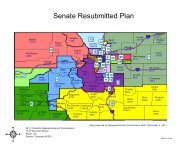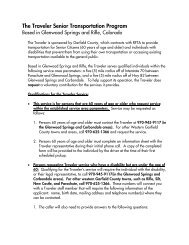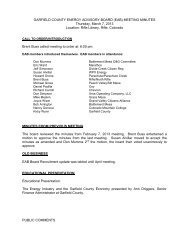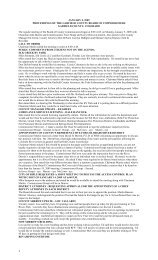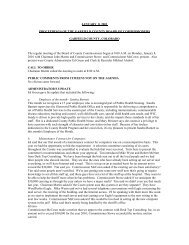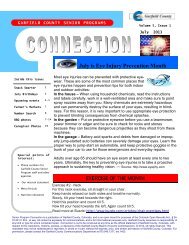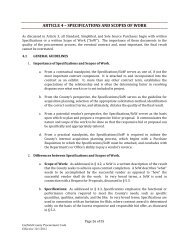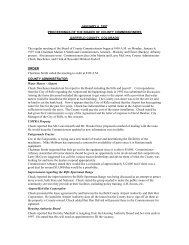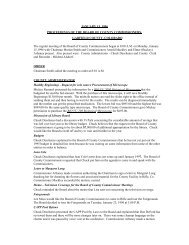Revegetation Guidelines - Garfield County, Colorado
Revegetation Guidelines - Garfield County, Colorado
Revegetation Guidelines - Garfield County, Colorado
Create successful ePaper yourself
Turn your PDF publications into a flip-book with our unique Google optimized e-Paper software.
<strong>Garfield</strong> <strong>County</strong> <strong>Revegetation</strong> <strong>Guidelines</strong><br />
from the<br />
<strong>Garfield</strong> <strong>County</strong> Noxious Weed Management Plan<br />
<strong>Revegetation</strong> and Rehabilitation:<br />
A crucial part of any weed management plan is the reintroduction of site appropriate<br />
vegetation.<br />
Establishing a desirable plant community after noxious weeds have been removed from a<br />
highly infested area requires timely cultivation and reseeding. Since the seeds from noxious<br />
weeds may lay dormant for many years, removing all visible signs of the noxious weeds does<br />
not ensure against their return. <strong>Revegetation</strong> can help prevent the germination of weed<br />
seeds. It is important to inspect the land regularly to identify and treat small, new infestations.<br />
For proper reclamation, managed irrigation of dry areas, fertilization, and reseeding are<br />
essential to establish desirable plant communities.<br />
Native plants are most appropriate when the goal is restoration (trying to restore native<br />
habitat). Weed-free seeds of native <strong>Colorado</strong> grasses, wildflowers or plant species<br />
appropriate to the site may be purchased, but the best source for seeds is from native<br />
species that grow in the immediate vicinity of the infestation. They will be best adapted to<br />
local conditions and will help maintain local integrity and genetic viability. Using native plants<br />
or seeds to reclaim disturbed land reduces degradation of native ecosystems, reduces the<br />
need for herbicides and conserves water resources. Native plants will provide a broad<br />
biological diversity and help keep <strong>Colorado</strong> looking like <strong>Colorado</strong> with a unique regional<br />
landscape that sets us apart from other areas of the country.<br />
When the goal is reclamation (reseeding for quick ground cover establishment or erosion<br />
control), it may be appropriate to use introduced, non-aggressive grasses and forbs.<br />
Contact the Natural Resources Conservation Service or <strong>Colorado</strong> State University<br />
Cooperative Extension for seeding recommendations. The Native Plant <strong>Revegetation</strong><br />
Guide for <strong>Colorado</strong>, published by the <strong>Colorado</strong> State Parks Natural Areas Program, is an<br />
excellent guide for native plant reseeding. Contact the <strong>Garfield</strong> <strong>County</strong> Vegetation<br />
Management office for further information on this material.<br />
STRATEGIES:<br />
Study all vegetation in the area and surrounding areas.<br />
Preserve plant species native to <strong>Colorado</strong>.<br />
Test the soil for pH balance. Try to retain and utilize as much on-site topsoil as possible.<br />
Select a predominant species that is appropriate to the site. Then choose a few<br />
complimentary species to provide a balanced plant community.<br />
Choose plants that are healthy, vigorous and pest free.<br />
Use weed-free seeds. Use non-hybrid seeds. Avoid commercial seed packets<br />
containing exotic plant species.<br />
Choose plants that are horticulturally appropriate, i.e. plant species that are adaptable to<br />
climate, soil and topographical conditions of the designated area.<br />
Consider the use of water, its availability and the vegetative requirements.<br />
To landscape for wildlife, choose native plants that provide cover, forage, browse, seeds<br />
for birds and rodents, and shade.<br />
Be site-specific; revegetation strategies may vary for small lots, farms, ranches or<br />
construction sites.<br />
1
Establish a vegetative cover that is diverse, effective and long lasting, capable of selfregeneration.<br />
Stabilize the surface.<br />
<strong>Garfield</strong> <strong>County</strong> Requirements (Adopted May 7, 2001)<br />
At the discretion of the Board of <strong>County</strong> Commissioners, as part of the Planning and Zoning<br />
approval process, for land disturbances outside the building envelope, the <strong>County</strong> may<br />
require, at preliminary plan and prior to Final Plat, the following items:<br />
A Soil Plan to include:<br />
o Provisions for salvaging on-site topsoil.<br />
o A timetable for eliminating topsoil and/or aggregate piles.<br />
o A plan that provides for soil cover if any disturbances or stockpiles will sit exposed for<br />
a period of 90 days or more.<br />
A <strong>Revegetation</strong> Plan to include:<br />
o Plant material list (be specific, scientific and common names required)<br />
o Planting schedule (to include timing, methods, and provisions for<br />
watering, if applicable)<br />
o A map of the area impacted at preliminary plan (where the soil will be<br />
disturbed)<br />
o A revegetation bond. (Agricultural practices are exempt from<br />
revegetation requirements unless they are in association with a<br />
subdivision or land use proposal.)<br />
A revegetation security may be required if, in the determination of the Board of <strong>County</strong><br />
Commissioners, the proposed project has:<br />
o A potential to facilitate the spread of noxious weeds.<br />
o A potential to impact watershed areas.<br />
o A potential for visual impacts from public viewing corridors<br />
o Steep slopes (15% or greater) or unstable areas.<br />
o Disturbs large areas (Half an acre or greater)<br />
The revegetation security will be in an amount to be determined by the Board of <strong>County</strong><br />
Commissioners that will be site-specific and based on the amount of disturbance. The<br />
security shall be held by <strong>Garfield</strong> <strong>County</strong> until vegetation has been successfully reestablished<br />
according to the following Reclamation Standards. The Board of <strong>County</strong> Commissioners will<br />
designate a member of their staff to evaluate the reclamation prior to the release of the<br />
security.<br />
2




